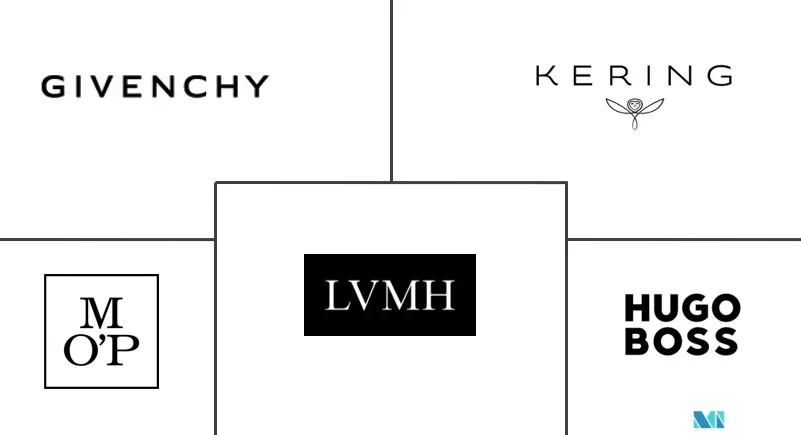Market Size of Germany Luxury Goods Industry

| Study Period | 2019 - 2029 |
| Base Year For Estimation | 2023 |
| Forecast Data Period | 2024 - 2029 |
| Historical Data Period | 2019 - 2022 |
| CAGR | 7.90 % |
| Market Concentration | Low |
Major Players
*Disclaimer: Major Players sorted in no particular order |
Germany Luxury Goods Market Analysis
Germany luxury goods market is projected to grow at a CAGR of 7.9% during the forecast period (2022-2027).
During the COVID-19 pandemic, the demand for luxury goods diminished drastically as stores remained closed under lockdown regulations and international travel was also restricted. Further, the financial crisis due to the rise in unemployment added to the decline in the luxury goods market during the pandemic.
Further, the pandemic has highlighted the importance of e-commerce and social media marketing for effective brand communication, which in turn has enabled luxury goods companies to recover from demand disruption. Additionally, key industry players have restructured their digital marketing strategies to compensate for the closure of brick-and-mortar stores. For instance, Hugo Boss reported in its annual report that the company had a 66% rise in its online sales during the fourth quarter of the financial year 2020.
Moreover, the upscale malls in the region like Aquis Plaza, Gesundbrunnen-Center, and Westfield Centro, among others have offered luxury brands ample space to expand their operations in the country. This, in turn, is anticipated to drive growth in the luxury goods market during the forecast period.
Germany Luxury Goods Industry Segmentation
Luxury goods are premium-priced products that are often linked with affluent people and serve as symbols of social status. Germany luxury goods market is segmented by type and distribution channel. By type, the market is segmented into clothing and apparel, footwear, bags, jewelry, watches, and other accessories. By distribution channel, the market is segmented into single-brand stores, multi-brand stores, online stores, and other distribution channels. The report offers market size and forecasts in value (USD million) for the above segments.
| By Type | |
| Clothing and Apparel | |
| Footwear | |
| Bags | |
| Jewelry | |
| Watches | |
| Other Accessories |
| By Distibution Channel | |
| Single-brand Stores | |
| Multi-brand Stores | |
| Online Stores | |
| Other Distribution Channels |
Germany Luxury Goods Market Size Summary
The Germany luxury goods market is experiencing a robust growth trajectory, driven by a combination of digital transformation and evolving consumer preferences. The COVID-19 pandemic initially caused a significant downturn in demand due to store closures and travel restrictions, but it also accelerated the shift towards e-commerce and digital marketing. Luxury brands like Hugo Boss have reported substantial increases in online sales, highlighting the effectiveness of revamped digital strategies. The presence of upscale malls and a strong e-commerce infrastructure, supported by high internet penetration and smartphone usage, has further facilitated the expansion of luxury brands in Germany. This shift in consumer buying behavior has been particularly pronounced in the fashion sector, where online purchases have surged, driven by the convenience and variety offered by digital platforms.
Sustainability has emerged as a key trend influencing the luxury goods market in Germany, with consumers increasingly seeking eco-friendly and ethically produced products. Brands are responding by investing in sustainable practices and product offerings, such as Jérome Studio's use of sustainable leather and olive leaf tanning. The market is characterized by a mix of international and local players, with major brands like LVMH, Kering, and Hugo Boss leading the charge. These companies are focusing on new product development and strategic partnerships to enhance their market presence. Initiatives such as HUGO BOSS's partnership with HeiQ AeoniQ to promote sustainability underscore the industry's commitment to aligning with consumer values. The market's fragmentation and competitive landscape continue to drive innovation and strategic collaborations, ensuring a dynamic growth environment.
Germany Luxury Goods Market Size - Table of Contents
-
1. MARKET DYNAMICS
-
1.1 Market Drivers
-
1.2 Market Restraints
-
1.3 Porter's Five Force Analysis
-
1.3.1 Threat of New Entrants
-
1.3.2 Bargaining Power of Buyers/Consumers
-
1.3.3 Bargaining Power of Suppliers
-
1.3.4 Threat of Substitute Products
-
1.3.5 Intensity of Competitive Rivalry
-
-
-
2. MARKET SEGMENTATION
-
2.1 By Type
-
2.1.1 Clothing and Apparel
-
2.1.2 Footwear
-
2.1.3 Bags
-
2.1.4 Jewelry
-
2.1.5 Watches
-
2.1.6 Other Accessories
-
-
2.2 By Distibution Channel
-
2.2.1 Single-brand Stores
-
2.2.2 Multi-brand Stores
-
2.2.3 Online Stores
-
2.2.4 Other Distribution Channels
-
-
Germany Luxury Goods Market Size FAQs
What is the current Germany Luxury Goods Market size?
The Germany Luxury Goods Market is projected to register a CAGR of 7.90% during the forecast period (2024-2029)
Who are the key players in Germany Luxury Goods Market?
Kering SA , LVMH Moët Hennessy-Louis Vuitton SE , HUGO BOSS AG , Givenchy and Marc O’ Polo Group are the major companies operating in the Germany Luxury Goods Market.

